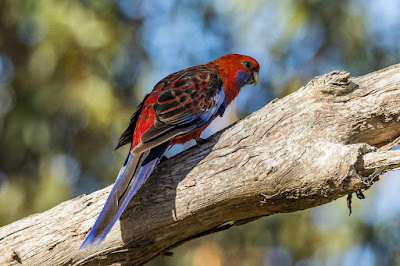Check my birding map for specific location.
Clarkesdale Bird Sanctuary is a wonderful haven for birds and other animals and is the result of decades of hard work to prevent habitat destruction and restore native vegetation. Best of all, you can camp there. It was really nice to be back in the van, waking up at first light to the dulcet tones of screaming Kookaburra!
The main area of the sanctuary is called the Bird Paddock and is a loop around a section of woodland with a long, thin lagoon on the far side. It is full of eucalpyt trees, some sporting rather spectacular mistletoe. The weather has been so changeable but it has been hot and hotter during my stay so the shade from the trees was really nice.
The first and most noticeable noise I could hear was the White-throated Treecreeper. It has an incessant, jackhammer ping and it keeps going until it runs out of breath. You can hear it try to keep going or pause to breathe. At times, I saw 2 together and there was a more pleasant, gentle trilling between them.
Crimson Rosella were everywhere throughout the woodland, with an occasional Eastern Rosella as well. Every pair of rosella seemed to have a juvenile with them and their colouring was very interesting with reds, greens and blues.
On site was the wonderful BirdLife Rep, Emily who took me out to look for the Tawny Frogmouth and we were fortunate enough to find them, sitting high up in the shade. My bird book describes the size of these birds as 34-52cm, which is a big range. The birds I saw in Queensland were certainly at the lower range, whereas this pair were very large. Interesting. I love how they watch you with those serious, glowing eyes.
Tawny Frogmouth (Podargus strigoides)
Emily also showed me some of the flowers in the paddock and my favourite was the Chocolate Lily. She told me it is so named because it smells of .... chocolate. I didn't quite believe her but the smell was pungent and of chocolate. Amazing.
On my second morning at Clarkesdale, I awoke to hear the Pallid and Fan-tailed Cuckoos calling. They both called solidly for 2 hours. Throw in the treecreeper, rosella and the distant strains of the oriole and it was very loud. I set off to look for the Pallid Cuckoo and it kept calling so was easy to find. Unfortunately, it was sitting up high and every now and then would be harrassed by honeyeaters and move on. Not the cracking shots I wanted but good to get the call on video.
There were lots of young birds and some still nesting. I found a couple of pardalote nests in small holes in the knots of trees. I couldn't get shots of them entering or leaving, they were just too fast. I did get this bird just waiting to feed its chicks. Not sure what it has in its mouth, looks yum though!
Another highlight of my stay was watching a pair of Sacred Kingfisher feeding their young. The nest was in a small hollow on the top of a culvert and the birds were returning every 10 minutes with food. They would land close by and chew up the food while trilling (presumably to reassure the chicks). Then, they would dart to the nest and drop off the food. All done in a couple of seconds. The nest was always in the shade but was a bit brighter in the afternoons. I stood at a distance, higher up than the nest several times in the hot sun waiting for the parents to return. After missing them twice, I trained my lens on the nest as soon as I could hear the birds come close. I waited and waited but the bird didn't go to the nest. I looked up and there it was, about 2m away from me at eye level. It was still chewing the food up. I'll settle for that.
eBird Lists











No comments:
Post a Comment